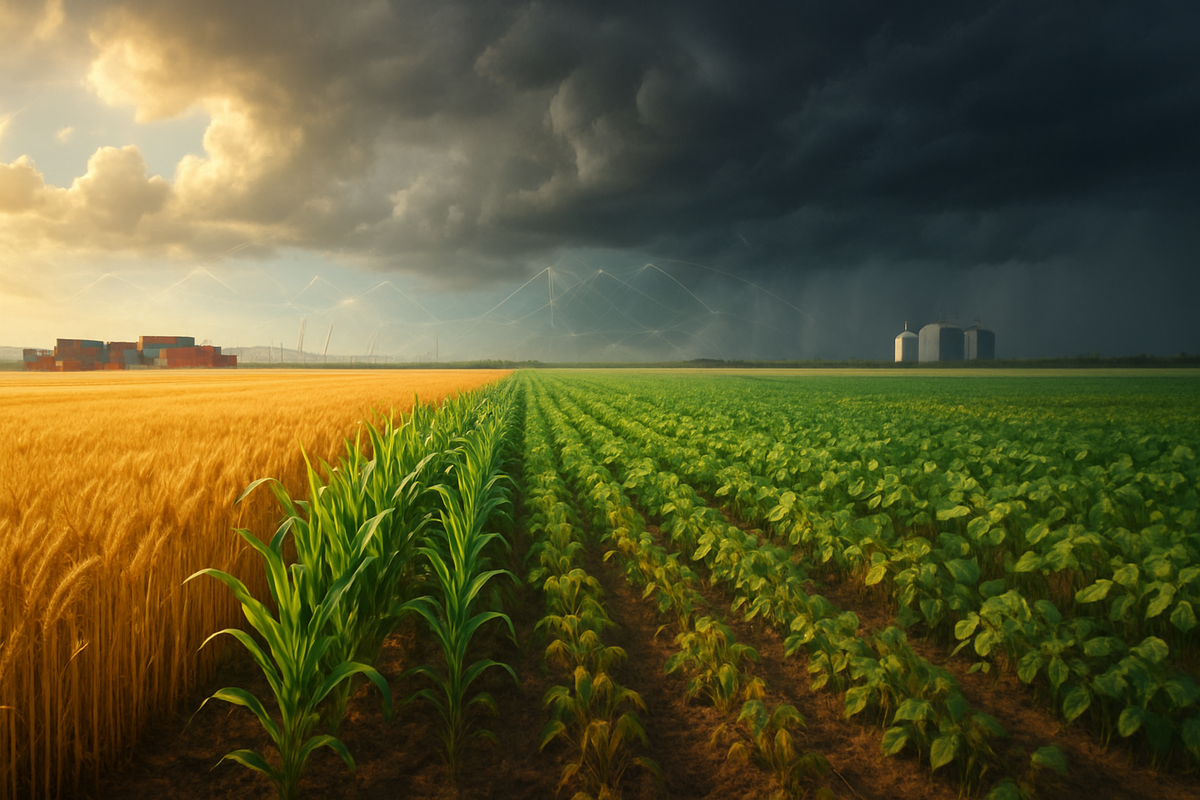
October 24, 2025 - Global agricultural commodity markets are currently navigating a tumultuous landscape, marked by significant price volatility and divergent trends across key crops. As of October 2025, a complex interplay of extreme weather events, escalating geopolitical tensions, persistent supply chain disruptions, and evolving demand patterns is dictating the rhythm of the market. While some forecasts point to a general softening of overall agricultural prices, the reality on the ground shows a mixed bag, with certain staples experiencing downward pressure while others surge due to acute vulnerabilities. This intricate web of factors is creating an environment of profound uncertainty for producers, consumers, and investors alike, reshaping the global food economy.
The immediate implications are far-reaching, translating into fluctuating food costs for consumers, unpredictable revenue streams for farmers, and strategic challenges for food processors and retailers. The absence of critical market data due to a recent US government shutdown, which suspended the USDA's monthly World Agricultural Supply and Demand Estimates Report, further exacerbates this uncertainty, leaving market participants without crucial transparency in grain and oilseed sectors. This data void, coupled with the ongoing external pressures, sets the stage for continued market turbulence in the months ahead.
A Deep Dive into the Driving Forces and Market Reactions
The current state of agricultural commodity prices is a direct consequence of several powerful forces converging simultaneously. Wheat prices, for instance, have been on a downward trajectory, with Minneapolis and Kansas City contracts continuing to fall in early October 2025, largely attributed to abundant global supplies and an anticipated 11.1% decrease in farm-level prices for the year. This contrasts with earlier 2025 projections that foresaw higher prices due to supply chain constraints. Meanwhile, corn has seen fluctuations, with prices slightly supported in early October but generally lower than earlier forecasts, settling around $4.23 per bushel on October 24, 2025, despite projections for record US output. Soybeans are expected to stabilize between $12 and $13 per bushel, though ample supply and declining Chinese demand have led to lower lows throughout 2025, even as Brazil anticipates a record harvest of 177.64 million tonnes for 2025/26. In stark contrast, coffee prices (Arabica and Robusta) have experienced significant surges, averaging much higher than in 2023, primarily due to their geographic concentration, long investment horizons, and lack of substitutability, making them highly vulnerable to disruptions.
The timeline of these events highlights a year of persistent challenges. Since the start of 2025, the World Bank's agricultural price index has declined by nearly 7%, with further decreases projected into 2026, though specific crop movements defy this broader trend. Geopolitical tensions, particularly the ongoing Russia-Ukraine war, continue to disrupt key trade routes and the supply of essential commodities and fertilizers, contributing to price volatility. The prospect of renewed trade wars, especially between the US and China, looms large, threatening to impose tariffs on over $30 billion in annual agricultural trade flows, potentially impacting US soybean exports and shifting Chinese demand towards South America.
Climate conditions remain a dominant and increasingly unpredictable "key player." Extreme heat, water scarcity, and erratic weather patterns are devastating yields globally. Climate change has already reduced wheat yields by 7–12% and could cut overall global crop yields by up to 10% by 2025. Supply chain issues, including disruptions in critical waterways like the Red Sea and Mississippi River, rising input costs (fertilizers up 16-39% since January 2025), and labor shortages, further compound the problem. Shifts in demand, driven by population growth, dietary changes, and biofuel policies, also play a significant role. The market's initial reaction to these factors has been one of heightened caution and price discovery challenges, especially with the absence of USDA data, leaving traders and analysts to operate with incomplete information.
Corporate Fortunes in the Balance: Winners and Losers
The volatile agricultural commodity market presents a mixed bag for public companies, creating distinct winners and losers depending on their exposure, geographic footprint, and strategic agility.
Companies positioned to win in this environment are often those with diversified crop portfolios, robust supply chain management, and significant operations in regions experiencing favorable weather and strong harvests. For instance, large-scale agricultural producers like Archer-Daniels-Midland (NYSE: ADM) and Bunge Global SA (NYSE: BG), with their extensive global networks in grain origination, processing, and merchandising, might capitalize on arbitrage opportunities arising from regional price discrepancies or secure advantageous supply contracts. Brazilian agricultural giants, benefiting from record soybean harvests, could see increased export volumes and revenues. Companies specializing in climate-resilient agriculture technologies or those offering crop insurance and risk management solutions may also find increased demand for their services as farmers seek to mitigate climate-related losses. Furthermore, fertilizer producers such as Nutrien Ltd. (TSX: NTR) and The Mosaic Company (NYSE: MOS), despite facing scrutiny over price increases, could benefit from sustained farmer demand for inputs, especially if global food security concerns remain high.
Conversely, companies heavily reliant on specific commodities experiencing price declines or those with significant exposure to regions hit by adverse weather or geopolitical disruptions are likely to lose. Small to medium-sized agricultural enterprises, particularly those in drought-stricken areas or facing escalating input costs without the scale to absorb them, could face severe financial strain. Food processors and consumer packaged goods companies, such as Kraft Heinz Company (NASDAQ: KHC) or General Mills, Inc. (NYSE: GIS), might see their profit margins squeezed by volatile raw material costs, especially for commodities like coffee that have surged in price. While they often have hedging strategies in place, extreme and prolonged volatility can still impact profitability. Furthermore, companies with significant trade ties to nations embroiled in potential trade wars, like those heavily exporting US soybeans to China, could face reduced demand and retaliatory tariffs, forcing costly shifts in sourcing and distribution. The increased cost of logistics and transportation due to Red Sea disruptions or low river levels also burdens companies relying on efficient global shipping.
Broader Implications and Historical Context
The current state of global agricultural commodity markets transcends mere price fluctuations; it signals a fundamental shift in the broader industry landscape. This volatility fits into a trend of increasing food insecurity and inflationary pressures observed globally over the past few years, exacerbated by the lasting effects of the COVID-19 pandemic and the Russia-Ukraine conflict. The emphasis on supply chain resilience, food sovereignty, and sustainable agricultural practices has intensified, becoming a central theme for governments and corporations alike. The recurring climate-induced disruptions highlight the urgent need for investment in climate adaptation and mitigation strategies across the agricultural sector.
The ripple effects extend far beyond primary producers. Food processing, retail, and hospitality industries face increased operational costs and the challenge of passing these costs onto consumers without dampening demand. This can lead to broader inflationary pressures, impacting consumer purchasing power and potentially slowing economic growth. Regulatory and policy implications are significant, with governments considering measures ranging from export restrictions to strategic grain reserves, and from biofuel policy adjustments to new agricultural subsidies aimed at stabilizing domestic food supplies. The prospect of renewed trade tariffs could trigger a cascade of protectionist measures, fragmenting global markets and increasing inefficiencies. Historically, periods of extreme agricultural commodity volatility have often coincided with geopolitical instability and economic downturns, serving as a stark reminder of the interconnectedness of food systems with global peace and prosperity. Comparisons can be drawn to the 2007-2008 food crisis, where a combination of high oil prices, adverse weather, and rising demand led to widespread social unrest and policy shifts.
The Road Ahead: Navigating Uncertainty
Looking ahead, the agricultural commodity market is poised for continued dynamism, with both short-term challenges and long-term opportunities. In the short term, ongoing geopolitical developments, especially regarding potential trade tariffs and the resolution of existing conflicts, will heavily influence price movements. Weather patterns in key growing regions, particularly the onset and severity of upcoming seasons, will dictate yield expectations and market sentiment. The return of comprehensive USDA data will be crucial for restoring market transparency and enabling more informed decision-making.
In the long term, strategic pivots towards enhanced supply chain resilience, technological innovation in agriculture (e.g., precision farming, drought-resistant crops), and diversification of sourcing will be paramount for companies. Market opportunities may emerge in areas such as alternative proteins, vertical farming, and sustainable agricultural inputs, driven by increasing consumer demand for environmentally friendly and resilient food systems. Challenges include managing the escalating costs of climate change adaptation, navigating complex international trade policies, and ensuring equitable access to food globally. Potential scenarios range from continued high volatility and regional food crises to a gradual stabilization driven by technological advancements and renewed international cooperation. However, the underlying pressures from climate change and geopolitical fragmentation suggest that the "new normal" for agricultural markets may be one of sustained, rather than temporary, volatility.
Key Takeaways and Investor Outlook
The global agricultural commodity market in October 2025 is a testament to the intricate and often unpredictable forces shaping our world. The key takeaway is the undeniable impact of climate change, geopolitical tensions, and supply chain fragility on global food systems, leading to a period of pronounced price volatility. This environment necessitates heightened vigilance and adaptability from all market participants. The market moving forward will likely remain sensitive to external shocks, with quick reactions to news regarding weather, trade policies, and conflict.
Investors should watch for several critical indicators in the coming months. These include updates on major crop harvests in key producing nations, any developments in international trade negotiations (particularly between the US and China), and the status of global shipping routes. Monitoring weather forecasts, especially for regions prone to extreme events, will be crucial. Furthermore, investor attention should be directed towards companies demonstrating robust risk management strategies, investments in sustainable agriculture, and diversified global operations, as these are likely to be better positioned to navigate the ongoing turbulence. The long-term trend points towards increased investment in agricultural resilience and innovation, making companies at the forefront of these solutions potentially attractive.
This content is intended for informational purposes only and is not financial advice





